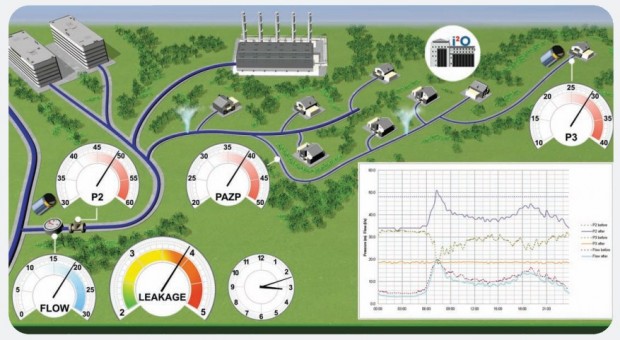
One of the major issues I’ve been seeing raised internationally in the last year is that of fresh water shortage. Do you remember that striking visualization of the entirety of our planet’s fresh water pictured next to the salt and the rest of the planet? Do you remember reading how in 20 or 30 years, populations will have expanded so much that fresh water will be “the new oil”? Like so many global threats, this one made its mark in the media and then receded to a distant memory. Such is the life of a meme, even an important one, but the water crisis is still imminent and some people are working to delay or prevent it.
We’re all careful not to make our showers too long, and not to leave the faucet running, but municipal water waste occurs massively on an institutional level as well. i2O is a centralized water control method that directs the distribution and pressure of an entire water system. Sure, it sounds like Plumbing 2.0, but this is actually a good example of a disruptive technology.
Bringing our utilities up to date and improving local adjustments (like reverse charge from solar panels, grid-independent entities, and so on) is essential to keep our cities operating at peak efficiency. Sounds a bit robotic, I know, but the fact is that as cities worldwide grow denser and larger, existing municipal utility management systems simply aren’t going to cut it.
And really, as there is so much overlap between water control and, say, internet traffic routing and smart electricity grids, that it’s inexcusable for a modern city of a million people to have anything but a highly sophisticated, predictive, data-rich utility management system.

i2O systems (that’s i two oh, not i twenty, if that wasn’t clear) have been installed in dozens of UK cities and save an average of nearly 50,000 liters a day each, as the system rerouted and adjusted pressure around leakages and inefficient pipes. There will still be bursts, and bad sealing, and we’ll still be losing a lot of water, but anything we can shave off the estimated 32 billion cubic meters of water lost from cities each year (World Bank estimate) is worth it.
The system is actually more practical in less developed countries, places where more modern piping and water control systems haven’t reached yet. They lose far more water to leakage and inefficiency — up to 50% from source to tap by the World Bank’s estimate. These are places that often have the least water to begin with, and therefore the least to spare.
 Unfortunately it doesn’t look as if the i2O system is likely to make it out there just yet. It’s extremely sophisticated, and relies on GSM signals, servers, custom valves, and so on to synchronize and update its network and get the best results. I get the feeling that the 200-year-old clay pipes being used in suburban Cairo are unlikely to be retrofitted any time soon. You have to have a functioning system to fix first, so of course efforts should be made to bring the developing world into the 20th century of water management before worrying about getting them into the 21st.
Unfortunately it doesn’t look as if the i2O system is likely to make it out there just yet. It’s extremely sophisticated, and relies on GSM signals, servers, custom valves, and so on to synchronize and update its network and get the best results. I get the feeling that the 200-year-old clay pipes being used in suburban Cairo are unlikely to be retrofitted any time soon. You have to have a functioning system to fix first, so of course efforts should be made to bring the developing world into the 20th century of water management before worrying about getting them into the 21st.
You can find out more about i2O at their website, along with a more technical explanation of the system and its advantages over existing water management solutions than seemed appropriate here.
I was going to write this post anyway, but it turns out that October 15th is Blog Action Day — and what luck is mine, this year’s cause is water! The problem addressed by i2O is certainly important, but there is much more to learn about and more interesting solutions in the offing than we have room to highlight here. That said, here are a few resources for those of you interested in learning more, donating, or perhaps even adding your blog to the festivities.
The World Health Organization has some good resources for learning about the threat of water scarcity in general, who is affected, and so on. Lots of links to international water causes.
Wikipedia’s page on water conservation has some useful tips and, as always, links to about a hundred interesting related links.
The New York Times has an interesting ongoing investigative series about pollution and water use in the USA. It might be good to brush up on the Clean Water Act if you’re going to get your outrage on.
Here is the picture I referred to in the intro, and here are some articles you might have missed when the water shortage meme was in flower, or more recently:
As climate changes, is water the new oil? (Reuters)
Steve Solomon and Jenny Price discuss the shortage (LA Times)
Tribes in Kenya Wage Water War (In These Times)
Downstream: Water Access and Sanitation News (Pulitzer Center)
Water: The Epic Struggle for Wealth, Power, and Civilization (book by Steven Solomon)
Keep fresh water shortage on your short list of global menaces with solutions in reach. Hopefully the other blogs participating in today’s event will add to the visibility of this worldwide problem.